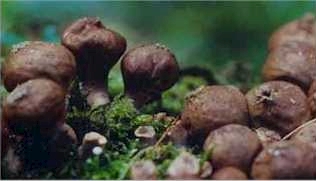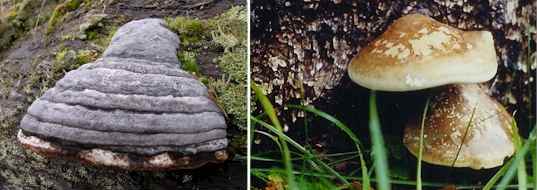..
MORE IMAGES FROM CHAPTER 2
Fig. 2.21. Basidiocarps of one of the bird’s nest fungi (genus Cyathus), about 1 cm diameter. These fungi are commonly seen in soil enriched with wood chippings. The small grey-brown cups open at maturity by rupture of the thin upper membrane (see arrows), revealing a cluster of egg-like peridioles. The basidiocarp acts as a splash cup. When rain drops hit the peridioles these are flung out of the cup, but each periodiole is attached to a thin funicular cord, with a sticky hapteron at its base, and this attaches to any object that it strikes, such as a leaf blade. [© Jim Deacon]
Fig. 2.22. Earth stars (Geastrum spp.), about 6 cm diameter, growing in leaf litter beneath birch trees. These cream-coloured basidiocarps are like puffballs, but are initially enclosed in thick outer wall layers. These layers split and curl back, helping to raise the basidiocarp above the leaf litter. Basidiospores develop and mature within the closed fruitbody, which then develops a pore at its tip. The spores are ‘puffed’ through this pore when raindrops hit the papery casing of the ‘spore chamber’.[© Jim Deacon]
Fig 2.23a Puffballs (Lycoperdon spp.) in an immature white stage. [© Jim Deacon]
Fig 2.23b. Puffballs of Lycoperdon spp. in the mature, brown stage (about 3 cm diameter). Puffballs produce basidiospores from basidia that develop within the fruitbody. The spores are not shot from the sterigmata but accumulate within chambers inside the developing fruitbody. [© Jim Deacon]
Fig. 2.24. Two common wood-rotting fungi of Scottish birch woods. Left: Fomes fomentarius (the hoof fungus), about 20 cm diameter. This hard, woody, perennial, bracket fungus is very common in Scottish birch woods, where it causes a brown rot. The underside of the basidiocarp consists of minute pores through which the basidiospores fall and are then wind-dispersed. Right: Bracket-shaped polypore fruitbodies of Polyporus betulinus, the 'razor strop' fungus. [© Jim Deacon]
Fig.
2.25. Left: an evanescent
bracket of Polyporus squamosus (Dryad’s
saddle), about 25 cm diameter, growing on a senescent
poplar tree. The spores are released through pores on the
underside. The bracket senesces and decays within a few
months and is usually replaced annually. Right:
A large, conical-shaped fruitbody of Phaeolus
schweinitzii, parasitic on the roots of coniferous
trees. The cap is about 15 cm diameter, and in this fresh
specimen it is covered with a downy felt on the upper
surface. |
|||||||||||





